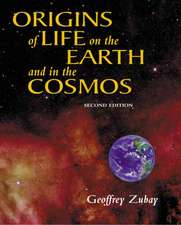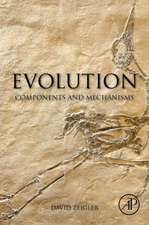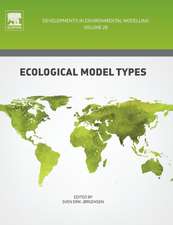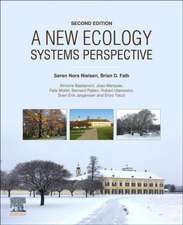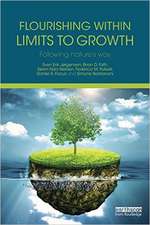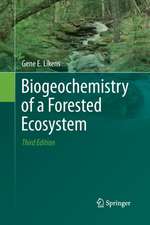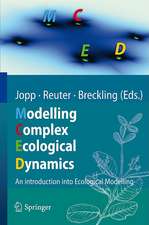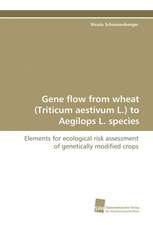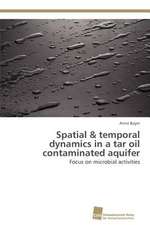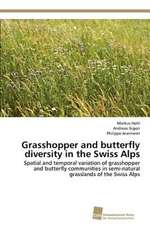Models of the Ecological Hierarchy: From Molecules to the Ecosphere: Developments in Environmental Modelling, cartea 25
Ferenc Jordan, Sven Erik Jørgensenen Limba Engleză Hardback – oct 2012
- Provides an excellent introduction to modelling
- Collects together in one source a wide range of modelling techniques
- Covers a wide range of topics, from the molecular level to the global ecosphere
Preț: 563.63 lei
Preț vechi: 725.78 lei
-22% Nou
Puncte Express: 845
Preț estimativ în valută:
107.87€ • 112.20$ • 89.05£
107.87€ • 112.20$ • 89.05£
Carte tipărită la comandă
Livrare economică 07-21 aprilie
Preluare comenzi: 021 569.72.76
Specificații
ISBN-13: 9780444593962
ISBN-10: 0444593969
Pagini: 594
Dimensiuni: 191 x 235 x 28 mm
Greutate: 1.32 kg
Ediția:New.
Editura: ELSEVIER SCIENCE
Seria Developments in Environmental Modelling
ISBN-10: 0444593969
Pagini: 594
Dimensiuni: 191 x 235 x 28 mm
Greutate: 1.32 kg
Ediția:New.
Editura: ELSEVIER SCIENCE
Seria Developments in Environmental Modelling
Public țintă
Environmental managers, ecologists and biologistsCuprins
Quantum chemical modeling in the molecular ecology; Cooperative molecules in the origin of life; Dealing with spatial autocorrelation in gene flow modeling; A virtual model for analyzing toxicity in cell-based assays; "Keystone species" of the molecular network of cellular functions;
Evolutionary transition to complex population dynamic patterns in a population with age structure; The maximum sustainable yield management of an age-structured salmon population; The influence of hydrodynamic processes on zooplankton transport and distributions in the north western Mediterranean sea estimated from a lagrangian model. Application to Pelagia noctiluca; Use of tracking system data for individual-based modeling of sweet fish (Plecoglossus altivelis) behavior; A mechanistic individual-based model of Oïkopleura dioïca; Modeling of processes of interspecific competition in the stand; Dynamic modes in a discrete two-sex age-structured three-component population model; Application of information theory models in the early detection of plant community degradation and prediction of vegetation changes; Body size determines community structure and dynamics; Modelling the Venice lagoon food web: a backcasting experiment; Trophic Network Analysis: Assessing the System-Wide Properties of Pastoral Ecosystems; Modeling interaction structure for food web with parasites; Dynamic Residence Time Analysis for Ecological Networks; Food web structure and trophic interactions of a tropical highland lake, Ethiopia; Modeling plant effects on salt marsh mercury cycling; Developing a model for the mercury cycle in the Marano-Grado Lagoon; Differentiating between the impact of global climate drivers and local anthropogenic pressures on the ecology of a mid-size South-Alpine lake; Modeling biogeochemical carbon dioxide and nutrient cycles in the North Sea with a 1D ERSEM Model; Comparative study of the cycling of mangrove litter nitrogen to the adjacent estuary through modeling in pristine and reclaimed islands of Sundarban mangrove ecosystem, India; ACQUANET and QUAL2K in water water quality control of the Nadela system in Serbia; Cities as Ecosystems: functional simlarity of simple analogy?; Three dimensional modeling of pollutant dispersion in Lake Garda (Northern Italy); DLES: a framewok for integrated modelling of forest ecosystems; Modelling of carbon cycling from mangrove litter to the adjacent Hooghly – Matla estuarine system, India; Modeling the effects of landscape changes caused by high altitude ski-pistes on bird species richness and distribution in the Alps; Forest coverage changes in Protected Areas: A fine-scale Markov chain approach
Development of program tool for determination of potential of landscape visual exposure; Open Source spatial algorithms applied to landscape genetics; Biodiversity conservation in dynamic landscapes: compensation of habitat patch destruction by habitat recreation; Combining habitat suitability models and fluvial functionality data for a multilayer assessment of riverine vulnerability; The worst scenario principle and the assessment of the impact of quality of life for biosphere dynamics; Carbon cycle modeling and principle of the worst scenario; Modeling and evaluating the energy flow in the global ecosystems and its impacts on human ecological footprint
Evolutionary transition to complex population dynamic patterns in a population with age structure; The maximum sustainable yield management of an age-structured salmon population; The influence of hydrodynamic processes on zooplankton transport and distributions in the north western Mediterranean sea estimated from a lagrangian model. Application to Pelagia noctiluca; Use of tracking system data for individual-based modeling of sweet fish (Plecoglossus altivelis) behavior; A mechanistic individual-based model of Oïkopleura dioïca; Modeling of processes of interspecific competition in the stand; Dynamic modes in a discrete two-sex age-structured three-component population model; Application of information theory models in the early detection of plant community degradation and prediction of vegetation changes; Body size determines community structure and dynamics; Modelling the Venice lagoon food web: a backcasting experiment; Trophic Network Analysis: Assessing the System-Wide Properties of Pastoral Ecosystems; Modeling interaction structure for food web with parasites; Dynamic Residence Time Analysis for Ecological Networks; Food web structure and trophic interactions of a tropical highland lake, Ethiopia; Modeling plant effects on salt marsh mercury cycling; Developing a model for the mercury cycle in the Marano-Grado Lagoon; Differentiating between the impact of global climate drivers and local anthropogenic pressures on the ecology of a mid-size South-Alpine lake; Modeling biogeochemical carbon dioxide and nutrient cycles in the North Sea with a 1D ERSEM Model; Comparative study of the cycling of mangrove litter nitrogen to the adjacent estuary through modeling in pristine and reclaimed islands of Sundarban mangrove ecosystem, India; ACQUANET and QUAL2K in water water quality control of the Nadela system in Serbia; Cities as Ecosystems: functional simlarity of simple analogy?; Three dimensional modeling of pollutant dispersion in Lake Garda (Northern Italy); DLES: a framewok for integrated modelling of forest ecosystems; Modelling of carbon cycling from mangrove litter to the adjacent Hooghly – Matla estuarine system, India; Modeling the effects of landscape changes caused by high altitude ski-pistes on bird species richness and distribution in the Alps; Forest coverage changes in Protected Areas: A fine-scale Markov chain approach
Development of program tool for determination of potential of landscape visual exposure; Open Source spatial algorithms applied to landscape genetics; Biodiversity conservation in dynamic landscapes: compensation of habitat patch destruction by habitat recreation; Combining habitat suitability models and fluvial functionality data for a multilayer assessment of riverine vulnerability; The worst scenario principle and the assessment of the impact of quality of life for biosphere dynamics; Carbon cycle modeling and principle of the worst scenario; Modeling and evaluating the energy flow in the global ecosystems and its impacts on human ecological footprint














